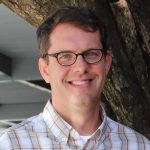Evaluating Long-term Nutrient Removal Performance
Well-maintained bioretention systems are like wine, they get better with age.
Key Questions and Findings
- How did a Bioretention Pond in Chapel Hill perform from construction in 2001 until 2018?
- This bioretention cell was well-maintained and was more efficient at removing nutrients 17 years after its construction than expected.
 Bill Hunt | NC State University
Bill Hunt | NC State University
Dr. Hunt is a William Neal Reynolds Distinguished University Professor and Extension Specialist in North Carolina State University’s Department of Biological and Agricultural Engineering. Hunt holds degrees in Civil Engineering (NCSU, B.S., 1994), Economics (NCSU, B.S., 1995), Biological & Agricultural Engineering (NCSU, M.S., 1997) and Agricultural & Biological Engineering, (Penn State, Ph.D., 2003). Since 2000, Hunt has assisted with the design, installation, and/or monitoring of over 150 stormwater control measures (SCMs), including bioretention, stormwater wetlands, innovative wet ponds, green roofs, permeable pavement, water harvesting/cistern systems and level spreaders. Also, Hunt is a native of the Jordan Lake watershed (born in Durham, NC).
